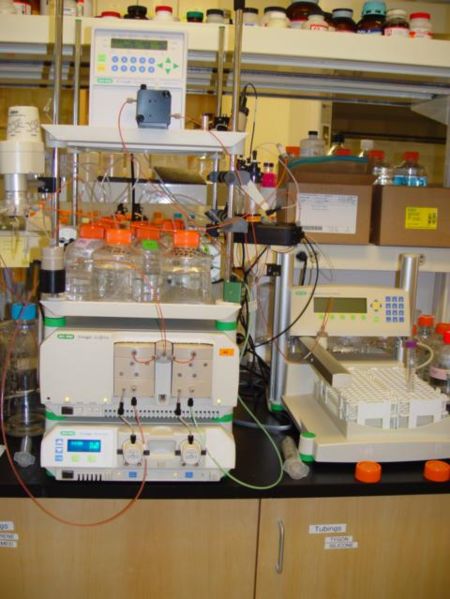|
Ammonium Sulphate
Ammonium sulfate (American English and international scientific usage; ammonium sulphate in British English); (NH4)2SO4, is an inorganic salt with a number of commercial uses. The most common use is as a soil fertilizer. It contains 21% nitrogen and 24% sulfur. Uses The primary use of ammonium sulfate is as a fertilizer for alkaline soils. In the soil the ammonium ion is released and forms a small amount of acid, lowering the pH balance of the soil, while contributing essential nitrogen for plant growth. The main disadvantage to the use of ammonium sulfate is its low nitrogen content relative to ammonium nitrate, which elevates transportation costs.Karl-Heinz Zapp "Ammonium Compounds" in ''Ullmann's Encyclopedia of Industrial Chemistry'', 2012, Wiley-VCH, Weinheim. It is also used as an agricultural spray adjuvant for water-soluble insecticides, herbicides, and fungicides. There, it functions to bind iron and calcium cations that are present in both well water and plant cells. ... [...More Info...] [...Related Items...] OR: [Wikipedia] [Google] [Baidu] |
Mascagnite
Mascagnite is a rare ammonium sulfate mineral ( N H4)2 S O4. It crystallizes in the orthorhombic system typically forming as stalactitic masses exhibiting good cleavage. It is soft (not higher than 2.5 on the Mohs Scale) and water-soluble. Optical properties are variable; the purest form is transparent and colorless, but opaque gray or yellow deposits are also known. It occurs in fumaroles, as at Mount Vesuvius and associated with coal seam fires. It was named for Italian anatomist Paolo Mascagni Paolo Mascagni (25 January 1755 – 19 October 1815) was an Italian physician and anatomist. He is most well known for publishing the first complete description of the lymphatic system. Biography Early life Mascagni was born in the co ... (1752–1815) who first described the mineral. References Ammonium minerals Sulfate minerals Orthorhombic minerals Minerals in space group 62 Mount Vesuvius {{sulfate-mineral-stub ... [...More Info...] [...Related Items...] OR: [Wikipedia] [Google] [Baidu] |
Alkaline Soil
Alkali, or Alkaline, soils are clay soils with high pH (greater than 8.5), a poor soil structure and a low infiltration capacity. Often they have a hard calcareous layer at 0.5 to 1 metre depth. Alkali soils owe their unfavorable physico-chemical properties mainly to the dominating presence of sodium carbonate, which causes the soil to swellManaging irrigation water quality, Oregon State University, USA Retrieved on 2012-10-04. and difficult to clarify/settle. They derive their name from the alkali metal group of elements, to which belong ... [...More Info...] [...Related Items...] OR: [Wikipedia] [Google] [Baidu] |
Ionic Strength
The ionic strength of a solution is a measure of the concentration of ions in that solution. Ionic compounds, when dissolved in water, dissociate into ions. The total electrolyte concentration in solution will affect important properties such as the dissociation constant or the solubility of different salts. One of the main characteristics of a solution with dissolved ions is the ionic strength. Ionic strength can be molar (mol/L solution) or molal (mol/kg solvent) and to avoid confusion the units should be stated explicitly. The concept of ionic strength was first introduced by Lewis and Randall in 1921 while describing the activity coefficients of strong electrolytes. Quantifying ionic strength The molar ionic strength, ''I'', of a solution is a function of the concentration of ''all'' ions present in that solution. :I = \begin\frac\end\sum_^ c_i z_i^ where one half is because we are including both cations and anions, ''c''i is the molar concentration of ion i (M, mol/L), ... [...More Info...] [...Related Items...] OR: [Wikipedia] [Google] [Baidu] |
Protein Purification
Protein purification is a series of processes intended to isolate one or a few proteins from a complex mixture, usually cells, tissues or whole organisms. Protein purification is vital for the specification of the function, structure and interactions of the protein of interest. The purification process may separate the protein and non-protein parts of the mixture, and finally separate the desired protein from all other proteins. Ideally, to study a protein of interest, it must be separated from other components of the cell so that contaminants won't interfere in the examination of the protein of interest's structure and function. Separation of one protein from all others is typically the most laborious aspect of protein purification. Separation steps usually exploit differences in protein size, physico-chemical properties, binding affinity and biological activity. The pure result may be termed protein isolate. Purpose The protein manufacturing cost remains high and there is a g ... [...More Info...] [...Related Items...] OR: [Wikipedia] [Google] [Baidu] |
Ammonium Sulfate Precipitation
Ammonium sulfate precipitation is one of the most commonly used methods for large and laboratory scale protein purification and fractionation that can be used to separate proteins by altering their solubility in the presence of a high salt concentration. Properties Ammonium sulfate is an inorganic salt with a high solubility that disassociates into ammonium () and sulfate () in aqueous solutions. Ammonium sulfate is especially useful as a precipitant because it is highly soluble, stabilizes protein structure, has a relatively low density, is readily available, and is relatively inexpensive. Mechanism Ammonium sulfate, as well as other neutral salts, will stabilize proteins by preferential solvation. Proteins are usually stored in ammonium sulfate because it inhibits bacterial growth. With the addition of ammonium sulfate, proteins unfolded by denaturants can be pushed into their native conformations. This can be seen with the folding of recombinant proteins. The solubility ... [...More Info...] [...Related Items...] OR: [Wikipedia] [Google] [Baidu] |
Glufosinate
Glufosinate (also known as phosphinothricin and often sold as an ammonium salt) is a naturally occurring broad-spectrum herbicide produced by several species of ''Streptomyces'' soil bacteria. Glufosinate is a non-selective, contact herbicide, with some systemic action. Plants may also metabolize bialaphos, another naturally occurring herbicide, directly into glufosinate. The compound irreversibly inhibits glutamine synthetase, an enzyme necessary for the production of glutamine and for ammonia detoxification, giving it antibacterial, antifungal and herbicidal properties. Application of glufosinate to plants leads to reduced glutamine and elevated ammonia levels in tissues, halting photosynthesis and resulting in plant death. Discovery In the 1960s and early 1970s, scientists at University of Tübingen and at the Meiji Seika Kaisha Company independently discovered that species of ''Streptomyces'' bacteria produce a tripeptide they called bialaphos that inhibits bacteria; it con ... [...More Info...] [...Related Items...] OR: [Wikipedia] [Google] [Baidu] |
Glyphosate
Glyphosate (IUPAC name: ''N''-(phosphonomethyl)glycine) is a broad-spectrum Herbicide, systemic herbicide and Crop desiccation, crop desiccant. It is an organophosphorus compound, specifically a phosphonate, which acts by inhibiting the plant enzyme 5-enolpyruvylshikimate-3-phosphate synthase. It is used to kill weeds, especially annual Forbs, broadleaf weeds and grasses that compete with crops. Its herbicidal effectiveness was discovered by Monsanto chemist John E. Franz in 1970. Monsanto brought it to market for agricultural use in 1974 under the trade name Roundup (herbicide), Roundup. Monsanto's last commercially relevant United States patent expired in 2000. Farmers quickly adopted glyphosate for agricultural weed control, especially after Monsanto introduced glyphosate-resistant Roundup Ready crops, enabling farmers to kill weeds without killing their crops. In 2007, glyphosate was the most used herbicide in the United States' agricultural sector and the second-most use ... [...More Info...] [...Related Items...] OR: [Wikipedia] [Google] [Baidu] |
Fungicide
Fungicides are biocidal chemical compounds or biological organisms used to kill parasitic fungi or their spores. A fungistatic inhibits their growth. Fungi can cause serious damage in agriculture, resulting in critical losses of yield, quality, and profit. Fungicides are used both in agriculture and to fight fungal infections in animals. Chemicals used to control oomycetes, which are not fungi, are also referred to as fungicides, as oomycetes use the same mechanisms as fungi to infect plants. Fungicides can either be contact, translaminar or systemic. Contact fungicides are not taken up into the plant tissue and protect only the plant where the spray is deposited. Translaminar fungicides redistribute the fungicide from the upper, sprayed leaf surface to the lower, unsprayed surface. Systemic fungicides are taken up and redistributed through the xylem vessels. Few fungicides move to all parts of a plant. Some are locally systemic, and some move upwardly. Most fungicides that can ... [...More Info...] [...Related Items...] OR: [Wikipedia] [Google] [Baidu] |
Herbicide
Herbicides (, ), also commonly known as weedkillers, are substances used to control undesired plants, also known as weeds.EPA. February 201Pesticides Industry. Sales and Usage 2006 and 2007: Market Estimates. Summary in press releasMain page for EPA reports on pesticide use ihere Selective herbicides control specific weed species, while leaving the desired crop relatively unharmed, while non-selective herbicides (sometimes called total weedkillers in commercial products) can be used to clear waste ground, industrial and construction sites, railways and railway embankments as they kill all plant material with which they come into contact. Apart from selective/non-selective, other important distinctions include ''persistence'' (also known as ''residual action'': how long the product stays in place and remains active), ''means of uptake'' (whether it is absorbed by above-ground foliage only, through the roots, or by other means), and ''mechanism of action'' (how it works). Historica ... [...More Info...] [...Related Items...] OR: [Wikipedia] [Google] [Baidu] |
Insecticide
Insecticides are substances used to kill insects. They include ovicides and larvicides used against insect eggs and larvae, respectively. Insecticides are used in agriculture, medicine, industry and by consumers. Insecticides are claimed to be a major factor behind the increase in the 20th-century's agricultural productivity. Nearly all insecticides have the potential to significantly alter ecosystems; many are toxic to humans and/or animals; some become concentrated as they spread along the food chain. Insecticides can be classified into two major groups: systemic insecticides, which have residual or long term activity; and contact insecticides, which have no residual activity. The mode of action describes how the pesticide kills or inactivates a pest. It provides another way of classifying insecticides. Mode of action can be important in understanding whether an insecticide will be toxic to unrelated species, such as fish, birds and mammals. Insecticides may be repellent ... [...More Info...] [...Related Items...] OR: [Wikipedia] [Google] [Baidu] |
Adjuvant
In pharmacology, an adjuvant is a drug or other substance, or a combination of substances, that is used to increase the efficacy or potency of certain drugs. Specifically, the term can refer to: * Adjuvant therapy in cancer management * Analgesic adjuvant in pain management * Immunologic adjuvant In immunology, an adjuvant is a substance that increases or modulates the immune response to a vaccine. The word "adjuvant" comes from the Latin word ''adiuvare'', meaning to help or aid. "An immunologic adjuvant is defined as any substance that ... in vaccines This is a specialized usage of a word (derived from the Latin verb "adjuvare", ''to help''), which also has a more general meaning as someone or something assisting in any operation or effect. {{sia Adjuvants ... [...More Info...] [...Related Items...] OR: [Wikipedia] [Google] [Baidu] |



